A Ghost Story for Christmas: The Mezzotint review – a glittering half-hour nugget

You’ll be in thrall to Mark Gatiss’s smart, snappy and utterly hammy ghost story within seconds. What a creepy Christmas gift to us all
Oh, the warm, expansive joy to be had from a chilly, compact ghost story! And A Ghost Story for Christmas: The Mezzotint (BBC Two), an MR James short story adapted by aficionado Mark Gatiss into a glittering half-hour nugget, is an absolute treat. These two masters of their forms can nudge even the most committed sceptic into willingly suspending their disbelief for a tight 30 minutes, especially when the plot runs like clockwork and is as stuffed with actors as a stocking is with gifts.
There is Rory Kinnear as Edward Williams, the curator of a university art museum who spends most of his days politely declining offers of unsuitable Delftware from local ladies. We are in Victorian Times so he has a Victorian Moustache and sometimes plays Victorian Golf, wearing Victorian Plus Fours. His friend Binks (John Hopkins) likewise (I assume there was a terrific two-for-one offer on in the BBC costume department). A dealer sends Williams an unremarkable mezzotint engraving of an unidentified manor house somewhere in Sussex or Essex – the label is torn.

Or IS IT so unremarkable? For when Binks looks at it, he thinks the moonlight is rather well done, and a figure at the edge adds interest. Williams somehow noticed neither of these things when it arrived. Ah well. Off he goes to Essex, because in his spare time he is investigating a family mystery involving a possibly illegitimate relative and calling up parish records at churches around the county. This time, they are brought to him by Frances Barber as Mrs Ambrigail, garrulous amateur paleontologist, wife of an indisposed vicar and soon-interested party. Barber (who is a national treasure and should be in everything) takes things right up to the ham line and no further – you couldn’t get a rasher between her and it – and provides the perfect shot of energy needed to carry the whole thing through to an ending even more pleasing than a bacon bap.
It is no spoiler to say that the engraving shifts. First the moonlight shines, the figure moves across the lawn, a window of the house opens, the figure disappears and reappears carrying … a child? The picture seems to tell the story of a tragedy – though when and where it is unfolding is at the heart of the mystery. If you’re not in thrall within moments, I really don’t know what to do with you. The engraving – the most static of all the arts – keeps changing! Come on!
Related: Mark Gatiss: ‘I’m currently very, very ashamed of being English’
There are sharp knocks at doors, mutterings of “Impossible!” under gentlemanly breaths, stiff drinks taken by fires, men reasserting their rational selves in front of mirrors, small but punchy parts for Emma Cunniffe as a disconcerted housekeeper and Robert Bathurst as an intrigued colleague, Binks chancing across a useful guide to Essex and many of its old manor houses, and a reappearance by Mrs Ambrigail with tales of infants, poachers and local lore to tie the whole thing together.
And The Mezzotint – thanks to Gatiss’s narrative interventions and the slithery physical talents of acrobat Tommaso di Vincenzo – sticks the landing. Obviously I can say no more. My only advice would be that if you are a father, be careful not to commit any sins you don’t want visiting upon your sons or any other eventual scions down the years.

 Yahoo News
Yahoo News 